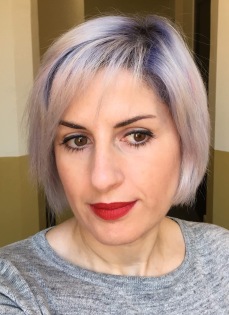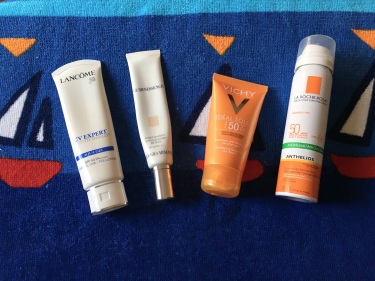So… before I pass the baton onto our guest blogger, Alkistis Klapsinou who has kindly agreed to write about one of our favourite topics: Sunscreens, this apart from our mutual love of Gin and hatred of cod science really got us chatting on a forum we are both a part of…I can hand on heart tell you this- what Alkistis doesn’t know about sunscreens or skincare for that matter, really isn’t worth knowing. Firstly I’ve got to show you what she looks like, so that you can see for yourself what a consistent routine with science driven skincare and daily SPF can make you look like ( especially if you’re in you’re 40’s…ps: it’s never too late) Now I’ll shut up and let Alkistis take over…

” We are in the middle of July and we are enjoying a heatwave the likes of which I have not experienced before in my 23 years in the UK. Well, I say “enjoying” – what I mean is I am enjoying it, while most of my friends’ reactions vary between tolerance and suffering with a lot of whinging thrown in for good measure. I, on the other hand, sit in pub gardens every evening, G&T in hand, without needing a cardi or a denim jacket. Bliss!
What’s all this got to do with beauty, you say? It’s the rule that you can’t have a heatwave without a blogpost (or seven) about sunscreen. It is most likely that if you are reading beauty blogs you are already using sunscreen. Aside from the obvious medical reasons, i.e. cancer, most people interested in beauty know that UV irradiation is the primary environmental factor of skin ageing. UV rays, and specifically UVA rays, are responsible for oxidative damage and breaking down of collagen in the skin ie: AGEING. The bad news is that unlike UVB rays (which are mostly responsible for burning and an issue in the UK between March and October), UVA rays are present all year round and they penetrate clouds and glass. Basically, there is no escaping them.
The problem is that there are no sunscreen products, at the moment, that protect just from UVA radiation, and which could, for example, be used just in the Winter months. So, we are stuck with using the same products all year round, or at least that is what we should be doing.

Another issue is that unlike Sun Protection Factor (SPF) which is a standardised way of measuring protection from erythema (redness caused by UV radiation – primarily UVB), there is no universal way of measuring protection from UVA. Some cosmetic companies use stars, some use PA followed by + signs, some give a Persistent Pigment Darkening rating, and some use a circle with UVA inside it. No wonder we are all confused. All these methods allow a product to be called Broad Spectrum, which means it protects from both UVA and UVB rays, but in all cases the UVA protection is only a ratio of the SPF/UVB protection. Therefore, it stands to reason that higher SPF sunscreens with as many + signs or stars as possible are the better option.
Now that we have established that we should be using a broad spectrum high SPF product all year round, the next question we need to answer is what the active filters in our sunscreen should be. We hear about mineral/physical/inorganic and chemical/organic and we need a degree in chemistry to understand what’s what. Zinc Oxide and Titanium Dioxide are mineral filters.
The list of chemical ones is much longer and includes, among others, Avobenzone, Octinoxate, Octocrylene, Octisalate, Bemotrizinol, Tinosorb M, Mexoryl SX & XL (I will not even try to write down the scientific ingredient names!)
- Mineral filters are photo-stable (i.e. they do not degrade when exposed to sunlight) and are less likely to cause irritation or an allergic reaction, so are recommended for sensitive and spot-prone skins. Their disadvantage, however, is that they have a thicker texture and can feel thick and greasy on the skin. They also cause flashback in photos, and can leave a white cast, especially on darker skins (which is why a lot of them are tinted). In more recent years the inclusion of nano-particles of mineral filters has resulted in nicer textures, but there is a lot of ongoing research as to whether these nano-particles can cross into the bloodstream and what the effects are. I will include some links below for further reading, so please do your own research on the matter.
- Chemical filters have the advantage of nicer textures (which is very important, because if you do not like how your sunscreen feels, you will not use it consistently or apply the recommended amount), particularly when used under make-up. However, some of them degrade in sunlight (Avobenzone and Octinoxate are particularly bad for this – links below) and while some others are used as ‘stabilisers’, this is the reason why it is recommended to reapply sunscreen every two hours (and obviously after swimming, sweating, etc.).
At this point I would like to differentiate between incidental UV exposure and sunbathing or prolonged exposure when on holiday. Walking to the bus stop in the morning, going for a short walk during your lunch hour and walking back home in the early evening are all incidental exposure. Most people should be able to put their sunscreen on in the morning and, provided this sunscreen is photo-stable, still be protected in the evening. It is a completely different situation if one is on holiday and spends all day in and out of the sun. In this case they should definitely reapply every couple of hours (or more frequently depending on how pale they are) and after swimming, showering, etc.
A lot of women believe that the SPF in their skincare or make-up provides enough protection for incidental exposure. This is a complete myth for various reasons. For a start, unless one checks the ingredients list of a product very carefully, there is no guarantee that a foundation with SPF20 will provide broad spectrum protection. Most importantly though, none of us apply as much product as one needs to achieve the advertised protection. (SCIENCE ALERT :SPF is calculated based on 2 mg of product per square centimetre of skin. For most people this is between 1/4 and 1/3 of a teaspoon just for the face. This is A LOT.) If I apply 1/4 of a teaspoon of foundation on my face I will look as if I am wearing a mask. No-one applies that much which is why we need a separate dedicated sunscreen.
In the last couple of years we keep hearing about anti-oxidants and how they “boost” the effects of sunscreen. I am not sure if “boosting” is the right term. What anti-oxidants (e.g. Vitamin C, Vitamin E, Resveratrol, Astaxanthin) do is prevent the oxidative damage to the skin caused by UV radiation. They work in synergy with the sunscreens. A lot of sunscreen products include anti-oxidants in their formulations, but using a separate one will do no harm and more often than not will help. I do feel this needs a separate post though, as I have waffled on enough.
As a last point, I can hear a lot of people asking “but what about Vitamin D?”. Vitamin D is synthesised in the skin via a reaction that is dependent on UVB radiation. More and more people are diagnosed as Vitamin D deficient and an increasing number of studies seem to link low Vitamin D levels with mental health problems. There is also ongoing research trying to establish Vitamin D’s role in autoimmune disorders like Lupus and Multiple Sclerosis. A healthy person needs approximately 20-30 minutes of unprotected daily exposure of their forearms to synthesise enough Vitamin D. The problem, in relation to sunscreens and beauty, is that in the UK we can only synthesise Vitamin D from late March to early October, because the rest of the year the angle of the sun in the horizon is such that UVB does not penetrate enough to trigger the aforementioned reaction in the skin. UVA, however, is present all year round. So, we get all the skin damage, without any of the benefits. It goes without saying that if you are concerned about your Vitamin D levels, you should consult your doctor.
To sum it up:
- Use a high SPF broad-spectrum photo-stable dedicated sunscreen all year round
- Use enough of it (2mg of product per square cm of skin)
- Top up if you are in the sun for prolonged periods of time
- Use an anti-oxidant alongside your sunscreen
Product recommendations(these are what I use and love – each person is different so your mileage may vary):
Lancôme UV Expert Youth Shield Aqua Gel SPF50 PA++++£38 ( Elle says: Good luck trying to find this one in the UK…only place its’s available seems to be at Duty free in the Airports)
Armani Luminessence Bright Revelator BB Fluid SPF50 PA+++ ( Elle says this is discontinued…thanks AK ❤)
Vichy Ideal Soleil SPF50 Mattifying Face Fluid Dry Touch ( Elle says that it’s £11.55 at the time of writing on All Beauty, and Escentual usually has year round deals)
Skinceuticals Ultra Facial UV Defense SPF50 ( Lowest price found at the time of writing is £33 from Effortless Skin)
La Roche Posay Anthelios Spray Anti-Shine SPF50 (as a top up)( Cheapest found is £9.33 from Escentual at the time of writing)
These are all from the L’Oreal/La Roche Posay group of companies, because for me and my skin Mexoryl SX and XL are the best filters and the patents are owned by L’Oreal/LRP.”
Further Reading – References:
https://onlinelibrary.wiley.com/doi/full/10.1111/phpp.12112 (everyone must read this)
https://onlinelibrary.wiley.com/doi/full/10.1111/j.1600-0781.2008.00365.x
https://kindofstephen.com/physical-vs-chemical-sunscreens-myths/
http://www.skinacea.com/sunscreen/uv-filters-chart.html
https://www.cancer.org.au/preventing-cancer/sun-protection/nanoparticles-and-sunscreen.html
https://www.futurederm.com/how-does-octinoxate-degrade-avobenzone/
https://www.ewg.org/sunscreen/report/whats-wrong-with-high-spf
– Written and researched by Alkistis Klapsinou
( Elle says…Alkistis to me is the last word on sunscreen, Alkistis researches this topic constantly and even discusses this topic with Doctors. I couldn’t think of a better person to write about Sun protection, so it was extremely kind of Alkistis to take the time out to research and write this for me. Thank you AK…I owe ya big time.xx)
Just an addendum with AK’s blessing, I really rate the La Roche Posay Anthelios XL fluid version which can always be found in deals online.
Have you tried any of these sunscreens? Do let me know in comments below, I would love to hear from you. ~Love Elle xx
Note of disclaimer: All opinions are my own, I have no affiliations with any company, there are no affiliate links on this post and all products are purchased with my own money . Please check ingredients list of all products that you buy, in case you have allergies to any of the products that I mentioned. If you are particularly sensitive or even if you’re not, allergies can happen suddenly, even with products that you have used for years. If unsure, please do a patch test on your elbow, and wait 48 hours before using any of the products I’ve suggested. Please do not copy, publish any photos on this blog or contents in its entirety or otherwise without my express permission.


I’ve depended on Alkistis’ SPF recommendations for years now! FWIW, I also really like Korean SPFS, as they also tend to be formulated with stable filters and have really nice textures.
http://www.cashmeremouse.com
LikeLike
I love Korean SPF’s i just think i dont always know whats on the inci list.
LikeLike